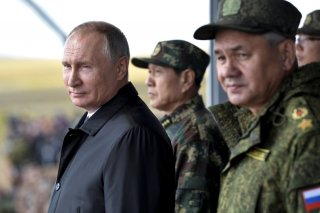Russia and China: Are U.S. Adversaries Aligning?
Sino-Russian ties are noticeably strengthening and will continue to strengthen so long as shared interests outweigh sticking points.
Russia and China wrapped up the five-day bilateral military exercise Zapad/Interaction 2021 in the Ningxia Hui Autonomous Region of northwestern China over a month ago on August 13. Approximately 10,000 troops participated in the drills alongside defense systems, artillery, armored vehicles, and combat aircraft, which included the debut of China’s fifth-generation J-20 fighter jet in a joint exercise. The stated theme of the exercise was jointly protecting regional peace and security in Central Asia—a rather prescient banner, given the total collapse of the Afghan government only days later.
Not to be confused with Zapad/Interaction 2021, the Zapad 2021 strategic command-staff exercise conducted by Russia and Belarus just concluded on September 16 with the surely-inflated number of 200,000 or the surely-deflated-number of 12,700 military personnel participating across fourteen training grounds in western Russia and Belarus. Russia has been conducting its quadrennial regional exercises—Zapad (West), Vostok (East), Tsentr (Center), and Kavkaz (Caucasus)—since the Soviet era, but their sizes have fluctuated over the decades, and linguistic smoke and mirrors have made numbers difficult to pin down.
China has participated annually in Russia’s major regional exercises since Vostok 2018. China and Mongolia were the first non-Soviet states to participate in one of Russia’s major regional exercises but only observed Zapad 2021. Russia and China packaged the Zapad/Interaction 2021 exercise as the opening act for the Zapad 2021 headliner that came a month later. Both Russian defense minister Sergei Shoigu and Chinese defense minister Wei Fenghe gave glowing remarks about their bilateral military relationship at the close of Zapad/Interaction 2021. Wei said, “This fully testifies to close relations between China and Russia, the indestructible ties between Chinese and Russian servicemen, and the strong and durable friendship between us personally.”
But Russian and Chinese actions are even more telling of warming military ties. Zapad/Interaction 2021 marked several “firsts” for the Sino-Russian military relationship: It was the first time Russian troops traveled to China for a joint strategic exercise, the first time Russia and China conducted drills under a joint command structure, and the first time Russian troops operated People’s Liberation Army (PLA) vehicles, including armored assault and infantry fighting vehicles. Though these are relatively small steps, they move the two countries toward military interoperability.
China’s lack of military participation in Zapad 2021 doesn’t negate a trend toward Sino-Russian alignment; instead, it demonstrates Russian and Chinese pragmatism, which lies at the heart of their bilateral relationship.
Richard Weitz, a senior fellow and director of the Center for Political-Military Analysis at the Hudson Institute, questioned whether the PLA would play a prominent role at Zapad 2021 in a July report on Sino-Russian military exercises for the Center for Strategic and International Studies. He wrote that the PLA’s involvement “could alarm the North Atlantic Treaty Organization (NATO) but also make less credible Russian options to use the drills as preparations for attacking Ukraine.” It seems the Kremlin opted for credibility.
China and Russia both value strategic autonomy and do not want military obligations where no mutual interests are at play—China does not want to get involved in Ukraine any more than Russia wants to get involved in Taiwan. But Sino-Russian ties are noticeably strengthening and will continue to strengthen so long as shared interests outweigh sticking points.
Russia and China have participated in bilateral and multilateral military drills since Peace Mission 2005, but the scope and frequency of these drills have increased over the past decade. After Russia seized Crimea in 2014 and its relations with the West deteriorated, Moscow has increasingly looked to Beijing for trade and political support, as well as military cooperation.
Now in mid-September, only a month after the end of Zapad/Interaction 2021, Peace Mission 2021, the longest-standing military drills involving Russia and China, are underway at the Donguz training ground in the Orenburg region of Russia. Like other recent Peace Mission exercises, this year’s installment has a Central Asian counterterrorism focus and operates under the banner of the multilateral bloc the Shanghai Cooperation Organization (SCO), although Russia and China typically spearhead the effort.
Since 2012, the two countries have also regularly participated in joint maritime exercises. To add another U.S. adversary into the mix—Russia, China, and Iran recently announced their third consecutive year of joint maritime exercises. The Marine Security Belt drills also known as CHIRU will take place in the Persian Gulf in late 2021 or early 2022.
China and Russia have bonded over similarities. Both countries have chilly relationships with the United States and share strategic concerns about Central Asia, which are particularly relevant now that the Taliban has retaken control of Afghanistan, and the region’s security context is shifting. For the West, the Sino-Russian military relationship is unnerving and must be vigilantly watched, but it must be watched with clear eyes. The Sino-Russian relationship is rooted in pragmatism. Russia and China might wield their alignment to poke at the United States, but they won’t wield it at the expense of vital national interests—and that is the West’s point of opportunity.
Jenna Biter is an editorial intern at The National Interest and an M.S. candidate in National Security at Liberty University interested in national security and Russian Area Studies.
Image: Reuters

